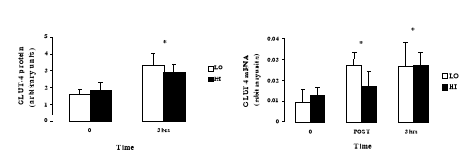APPS
November 2002 Meeting
Abstract 1217
ACUTE EXERCISE AND GLUT-4 EXPRESSION IN HUMAN SKELETAL MUSCLE: INFLUENCE OF EXERCISE INTENSITY
Mark Hargreaves, Yorgos N. Kraniou, David Cameron-Smith, Exercise & Muscle Metabolism Unit, School of Health Sciences, Deakin University, Vic.
Sarcolemmal glucose transport during insulin stimulation and exercise is mediated via the glucose transporter isoform GLUT-4. We have recently observed that a single exercise bout increases GLUT-4 mRNA in human skeletal muscle1. The purpose of the present study was to examine whether exercise intensity influenced the magnitude of exercise-induced increases in GLUT-4 mRNA and protein expression in human skeletal muscle. Six healthy, physically active, but untrained, men (age: 22.8 ± 1.6 yrs; mass: 84 ± 5 kg; VO2 peak: 3.9 ± 0.2 l.min-1 ) completed two exercise bouts matched for total work (60 min at 39 ± 3% VO2 peak - LO vs. 27 + 2 min at 83 ± 2% VO2 peak - HI). The order of the trials was counter-balanced and they were conducted at least one week apart. Muscle samples were obtained from vastus laterails by needle biopsy before, upon cessation of exercise and after three hours of passive recovery and later analysed for GLUT-4 mRNA (Taqman real-time PCR) and protein (immunoblotting) expression.

Exercise resulted in significantly greater glycogen degradation in HI compared with LO (Δglycogen = 146 ± 34 and 251 ± 24 mmol.kg-1dry wt for LO and HI trials respectively, P<0.05). GLUT-4 mRNA was increased immediately after exercise (~2-fold, P<0.05) and remained elevated (P<0.05) after three hours of recovery (Figure right panel). There were no differences observed between LO and HI. Similarly, GLUT-4 protein, measured three hours after exercise, was increased (P<0.05) ~50% in both trials (Figure left panel).
Our results indicate that the exercise-induced increases in GLUT-4 mRNA and protein expression in human skeletal muscle are independent of exercise intensity, at least when total work is matched.
Kraniou Y, Cameron-Smith D, Misso M, Collier G, Hargreaves M. Journal of Applied Physiology. 2000;88:794-796.
